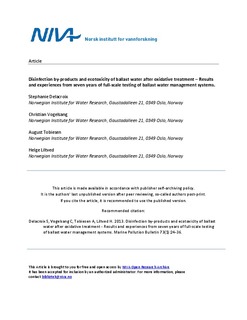Disinfection by-products and ecotoxicity of ballast water after oxidative treatment – Results and experiences from seven years of full-scale testing of ballast water management systems
Journal article, Peer reviewed
Date
2013Metadata
Show full item recordCollections
- Scientific publications [1172]
Original version
Delacroix S, Vogelsang C, Tobiesen A, Liltved H. 2013. Disinfection by-products and ecotoxicity of ballast water after oxidative treatment - Results and experiences from seven years of full-scale testing of ballast water management systems. Marine Pollution Bulletin 73(1):24-36 10.1016/j.marpolbul.2013.06.014Abstract
Since 2005, five different ballast water management systems (BWMS) based on chlorination treatment have been tested by Norwegian Institute for Water Research (NIVA) according to guidelines from the International Maritime Organization (IMO). 25 % and >50 % of all the tested discharge samples exhibited acute and chronic toxic effects on algae, respectively. In most cases this toxicity was plausibly caused by a high free residual oxidant (FRO) level (>0.08 mg Cl/l). Of the 22 disinfection by-products (DBPs) that were identified in treated water at discharge, four compounds were at times found at concentrations that may pose a risk to the local aquatic environment. However, there seemed to be no clear indication that the measured DBP concentrations contributed to the observed algal toxicity. The addition of methylcellulose instead of lignin in the test water to comply with IMO requirements seemed to limit the formation of DBP.
